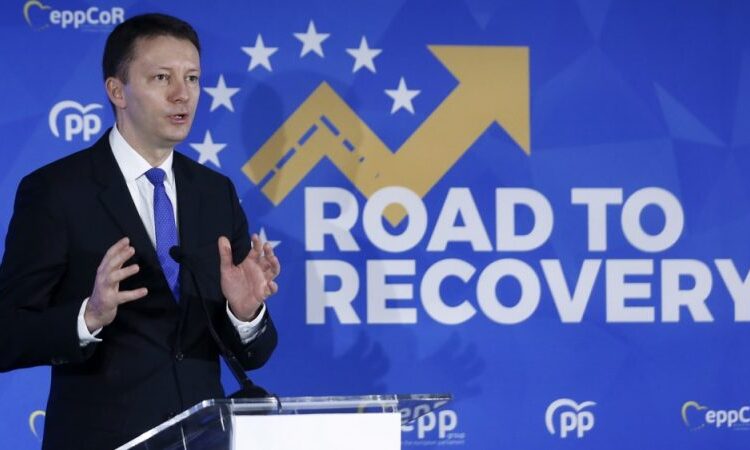
Centre-right and national-conservative groups in the European Parliament have voiced strong opposition to a renewed joint-debt programme at the EU level, after calls for a Recovery and Resilience Facility (RRF) ‘2.0’ mushroomed over the last few weeks to close a gap for public investments.
In 2021, the EU set out a hefty €723 billion funding programme to tackle member states’ needs to recover from the Covid-induced economic crisis and sustain their domestic-sector green and digital transition – within the ‘Next Generation EU’ plan.
Of that agreed capacity, €385 billion would be available to member states in the form of loans, which would have to be repaid by national governments – and €338 billion would be disbursed in the form of grants, meaning that debt repayments for these would be financed out of the EU budget.
With the final deadline for loan applications now passed (August 2023) and fund disbursement to be finalised by 2026, calls are on the rise to create a follow-up programme to ensure member states can continue to tap into vital resources: many national economies are still grappling with compressed growth and (presumably long-term) energy-transition hurdles.
However, conservative MEPs are starting to signal they would strongly oppose such proposals, making it less likely that such a programme would ever see the light of day – at least in the same shape or form.
The RRF was “designed as an exceptional, unique one-time instrument in a time of an unprecedented crisis”, Siegfried Mureşan, Vice Chair of centre-right EPP group in the European Parliament, told Euractiv.
“I know that the Socialists would always tell you that the solution is spending more of people’s money, but throwing money at problems does not always solve the problem,” he said, in reference to a statement made by Economy Commissioner Paolo Gentiloni, who hails from the Italian centre-left PD party (S&D).
Gentiloni said at a Commission press conference on the RRF interim report last week that he doesn’t think “the need for common support for common goals and common projects will end in 2026”.
Similar arguments were put forward by several think tanks working on the green and digital transitions, with warnings that after the RRF rollout ends, there will be a looming gap in public investments.
“We simply have an investment gap that will open up from 2026, i.e. the moment the recovery instrument expires,” Nils Redeker, deputy director of the Jacques Delors Centre Berlin, told Euractiv.
“There will be a lack of funds for green investments, for investments in digitalisation and also for many of the industrial policy measures that are currently underway,” he added.
While the RRF was set up during the Covid pandemic and distributed on a larger scale to countries that were particularly hit hard by the crisis, 37% of overall spending has to be spent on green measures, while 20% has to be used to help digitalisation, according to the rules set by the EU.
Johan Van Overtveldt of the national conservative ECR group, who also leads the Parliament’s Budget Committee, highlighted that the RRF was intended to help countries improve their overall economic resilience.
“So if now people say that there is a need for a second vehicle, to keep things going, then my reply is quite simply, then we have not used the money well in the original RRF,” he added.
“And […] if the money was spent well, then there is no need for a new one,” Van Overtveldt said.
“So either way: Stop it. Don’t renew it,” he concluded.
Socialists in favour of new fund
With the RRF wrapping up in 2026 and the current EU budget ending in 2027, the next European Parliament, which will be elected in early June, will face the arduous task of finding new solutions for longer-term funding needs.
However, long-term financial planning is usually done by EU leaders at special summit meetings, as happened in the summer of 2020 when the Next Generation EU programme was first adopted.
As projected based on current polls, the EPP will continue to be the largest group in the next European Parliament, while the ECR could rise to the third rank.
Second-placed Socialists & Democrats (S&D) group is in favour of a new programme for when the current RRF ends.
“Digital and Climate transitions, defence, European Pillar of Social Rights implementation or EU Strategic Autonomy – key EU priorities – require huge EU investments,” Margarida Marques (S&D), Vice Chair of the Budget Committee, told Euractiv.
Some substantial level of EU investment capacity “is therefore needed in the future in order to implement these EU priorities [while] avoiding market fragmentation and [while avoiding] increasing divergences”, she added, referring to the time after 2026 when the current RRF ends.
Repayment of current debt unclear
The EPP’s Mureşan, however, said that discussing a new programme would be premature also because it remains unclear how the debt already disbursed within the current RRF will be repaid.
Of the original funds available, a total of €291 billion in loans were applied for, while the portion represented by grants was fully utilised.
Referring to the latter, Mureşan said: “It is not clear who and how [we] will pay back this half of the ‘Next Generation EU’.”
“And unless this is clarified, I would strongly, very strongly advise us against making more debt and putting more debt burden on the shoulders of the people of Europe,” he added.
In 2021, the European Commission proposed new streams of revenue to the EU budget to finance the repayment of the debt, including using parts of the revenue of the EU’s Emissions Trading System (ETS), which currently mostly goes to national budgets.
However, “little progress has been achieved” on these proposals, a Commission spokesperson told Euractiv.
Other proposals include taking money from the EU’s newly introduced carbon tariff (CBAM) as well as additional payments from national budgets, such as based on corporate profits.
“All proposals are on the table,” the spokesperson said, adding, “the Commission urges the Member States to agree on New Own Resources as soon as possible.”
If no agreement on new revenue streams can be found, the debt repayment legally has to happen out of the EU budget, which would in turn risk squeezing funds for other EU programmes.
“Even without the introduction of own resources, the repayment of NGEU through the EU budget is guaranteed,” the spokesperson highlighted.
[Edited by Anna Brunetti/Nathalie Weatherald]







